Notice of Intention to Designate - 6 Properties (CBM & Tim Horton)
TAKE NOTICE that the Town of Caledon intends to designate the following properties as being of cultural heritage value or interest under Section 29 of the Ontario Heritage Act, R.S.O. 1990, Chapter O.18:
1420 Charleston Sideroad
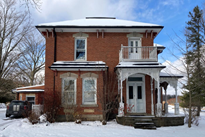
The property is located on the north side of Charleston Sideroad, west of Main Street/Cataract Road, being Part of Lot 16, Concession 4 WHS, within the former geographic Township of Caledon.
Built between 1891 and 1901 for George Cameron, the red brick farmhouse at 1420 Charleston Sideroad on the lands is representative of the Italianate architectural style with its two-storey massing, hipped roof with wide overhanging eaves and decorative brackets, dichromatic stone accents including segmental stone eyebrow arches and carved lug sills on window and door openings, wood frames with arched head accents on window and door openings and decorated wooden arcaded side porch. The farmhouse is setback from the road, accessed by a long driveway lined with mature trees. Mature trees are located throughout the property. At the rear of the farmhouse are the fieldstone foundation ruins of the original barn, likely constructed at the same time as the main block of the house, and a low fieldstone wall extends from Charleston Sideroad to the rear of the property, on the southwest side of the driveway and house.
The property is historically linked with the Cameron family, who farmed Lot 16 from the early 19th century. A direct relative of the subject Cameron family is believed to be James Francis Cameron, an internationally celebrated Canadian filmmaker.
As a 19th century farmstead, the spatial organization and mix of structural elements on the property maintains and supports the rural agricultural character of the wider area.
18722 Main Street

The property is located on the west side of Main Street, north of Charleston Sideroad, being Part of Lots 17 and 18, Concession 4 WHS, within the former geographic Township of Caledon.
Built between 1899 and 1905 for James Cameron, the red brick farmhouse is representative of the Italianate architectural style with its two-storey massing, hipped roof with wide overhanging eaves and decorative brackets, dichromatic stone accents including segmental stone eyebrow arches and carved lug sills on window and door openings, and wood frames with carved arched head accents on window and door openings. The farmhouse is set back from the road, accessed by a driveway lined with mature trees. At the rear of the driveway, to the south of farmhouse is a three-bay timber-framed barn built in the gable-roof Central Ontario style, likely constructed at the same time as the house.
The grouping of contemporary elements such as the farmhouse, barn, and tree-lined drive supports the contextual value of the property. This complex is closely tied, both physically and historically, to similar properties in the surrounding area. As a turn of the century farmstead, the spatial organization and mix of structural elements on the property maintain and supports the rural agricultural character of the wider area.
18501 Mississauga Road
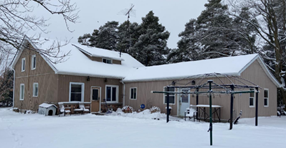
The property is located on the east side of Mississauga Road, north of Charleston Sideroad, being Part of Lot 16, Concession 4 WHS, within the former geographic Township of Caledon.
The property has design value as a representative and rare example of an early 19th century farmhouse in the Town of Caledon. Built between 1836 and 1848 for John Cameron, the one-and-a-half storey, vernacular style residence is a rare surviving example of an early 19th century farmhouse in the community. A late 19th century barn with fieldstone foundations and a gable roof is located to the northwest of the farmhouse and an early 20th century barn with concrete foundations and a gambrel roof is located to the east.
As a 19th century farm complex, the spatial organization and mix of structural elements on the property maintain and supports the rural agricultural character of the wider area. The house, barn complex, and mature vegetation on the property are both physically and historically linked to each other and physically and historically linked to their surroundings.
18667 Mississauga Road
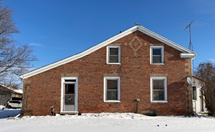
The property is located on the east side of Mississauga Road, north of Charleston Sideroad, being Part of Lot 17, Concession 4 WHS, within the former geographic Township of Caledon.
Built between 1846 and 1858 for Duncan Cameron Sr., the farmhouse features elements of various styles which were popular as the house evolved over the middle of the 19th century. Constructed as a single storey timber frame house, the house was subsequently expanded and reclad in brick between 1861 and 1891. The use of hand-hewn timbers as floor joists in the main block and the use of hand-hewn timbers and mortise and tenon joinery in the summer kitchen was a common construction method during the early to mid-19th century. The single storey, symmetrical, rectangular form and center-hall floorplan were popular during the early to mid-19th century. When the side addition was constructed between 1861 and 1891 architectural styles had shifted to embrace elements such as larger individual windowpanes, dichromatic brick patterns and accents, and wide porches or verandahs.
The farmhouse is setback from the road, accessed by a long driveway lined with mature trees and low fieldstone walls. A late 19th century barn complex is located to the northwest of the farmhouse, featuring two Central Ontario style barns linked by a connecting shed, and a late 19th or early 20th century drive shed is located to the north of the farmhouse.
As a 19th century farmstead, the spatial organization and mix of evolved structural elements on the property maintain and supports the rural/agricultural character of the wider area. The house, barn complex, fieldstone walls, and mature vegetation on the property are both physically and historically linked to each other and physically and historically linked to their surroundings.
16054 Airport Road
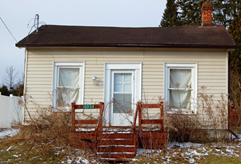
The property is located on the west side of Airport Road, south of Walker Road West, being Lot 7 on Plan CAL-4, in the village of Caledon East.
The property’s design value or physical value is linked to its one storey dwelling known locally as the Pettigrew House, a rare and early example of Neoclassical architecture in Caledon East. Built c.1857, the dwelling is believed to be the oldest surviving structure on the village’s main street. Architectural elements that are characteristic of the Neoclassical style of the early to mid-19th century period include its: rectangular form; one-storey massing; medium pitch gable roof; symmetrical three-bay front façade with a centre entrance and large window openings on each side; fluted door and window surrounds; and one-storey rectangular rear addition with gable roof centred on the main house block.
The property has historical value and associative value for its ownership/occupancy by a series of prominent local families who contributed to the early growth and development of Caledon East. It is directly associated with Henry and Catherine Pettigrew for whom the dwelling was likely constructed between 1857 and 1861. Henry Pettigrew ran a saddlery business in the village and served as Peel County Division Court clerk for over 10 years. The subsequent use of this village residence by retired area farmers and their families and by local tradesmen such as the village blacksmith reflects themes that are significant to rural village life. The survival of this modest structure in near original condition, with 19th and early/mid 20th century additions, contributes to an understanding of the early mid-19th century residential character and fabric of the main street of Caledon East and the evolution of the village as a rural agricultural service centre.
The property has contextual value for its contribution in defining, maintaining and visually supporting the rural main street character and fabric of Airport Road and Caledon East with its mix of commercial and residential buildings with varied setbacks. The property is physically, visually and historically linked to its surroundings as an original lot within the village’s first plan of subdivision (1855) and containing its original c.1857 dwelling set close to the street edge. The mature trees and landscaping on the property are consistent with the rural village character.
16060 Airport Road
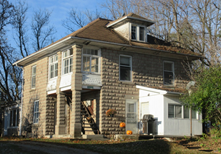
The property is located on the west side of Airport Road, south of Walker Road West, being Lot 8 on Plan CAL-4, in the village of Caledon East.
The property’s design value or physical value is linked to its two-storey dwelling, known locally as the Donaldson House. Built in 1907, as attested by a datestone on its upper front (east) façade, the Donaldson House is a representative and early example of a local vernacular adaptation of the American Four-Square style popular in the early 20th century. It is the first rusticated concrete block house known to have been constructed in Caledon East by the local construction firm of White & Proctor following its purchase of a concrete block making machine in 1906. A locally unique feature of the house design, rare in the broader district, is its two-storey side porch incorporated under the southeast corner of the dwelling square roof, creating an L-shaped floor plan. The Donaldson House displays a high level of integrity.
The property has historical value and associative value for its direct association with James Alexander and Jennie Donaldson, for whom the Donaldson House was constructed. James Donaldson operated an undertaking and furniture business in Caledon East for forty-three years, playing a key service role in the community and broader district, including the establishment of the Caledon East Public Cemetery in 1906. The property has additional historical value and associative value as it reflects the work of prominent Caledon East builders Joseph O. Proctor and Samuel W. White, owners of the White & Proctor planing mill and cement works, who played a significant role in the community’s development in the late 19th and early 20th century.
The property has contextual value for its contribution in defining, maintaining and supporting the rural main street fabric and character of Airport Road in the core of Caledon East with its mix of commercial and residential buildings with varying setbacks and construction dates. The setback and scale of the Donaldson House make it a prominent structure in Caledon East’s core. It is visually and historically linked to other rusticated concrete block buildings constructed by White & Proctor in Caledon East.
CONTACT
Please contact Heritage staff at heritage@caledon.ca for further information regarding the cultural heritage value and heritage attributes of these properties.
RIGHT TO OBJECT
Any person may, within thirty days after publication of this notice, dated March 7, 2024, serve the Clerk notice of their objection to the proposed designation in accordance with the Ontario Heritage Act, setting out the reason for the objection and all relevant facts.
By email: By mail, courier or personal delivery attention:
Kevin Klingenburg Kevin Klingenberg, Corporate Services/Town Clerk
Town Clerk 6311 Old Church Road
kevin.klingenberg@caledon.ca Caledon ON L7C 1J6



 Subscribe to this page
Subscribe to this page